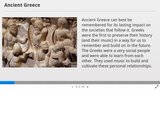
Slideshow of ancient Greece
- Subject:
- Arts and Humanities
- Performing Arts
- Material Type:
- Interactive
- Provider:
- Michigan Virtual
- Date Added:
- 12/13/2018

Slideshow of ancient Greece
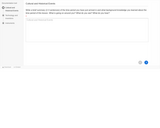
Short sentence questionnaire on ancient times

SPARK explores the electro-acoustic world of Paul Dresher - musician, composer and inventor - as he prepares for a performance of a new work at Yerba Buena Center for the Arts. This Educator Guide traces the legacy of new instrument development and experimentation and its impact on music.
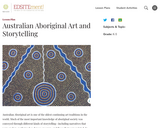
Australian Aboriginal art is one of the oldest continuing art traditions in the world. Much of the most important knowledge of aboriginal society was conveyed through different kinds of storytelling—including narratives that were spoken, performed as dances or songs, and those that were painted. In this lesson students will learn about the Aboriginal storytelling tradition through the spoken word and through visual culture. They will have the opportunity to hear stories of the Dreamtime told by the Aboriginal people, as well as to investigate Aboriginal storytelling in contemporary dot paintings.
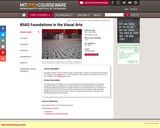
Offers a foundation in the visual art practice and its critical analysis for beginning architecture students. Emphasis on long-range artistic development and its analogies to architectural thinking and practice. Learn to communicate ideas and experiences through various two-dimensional, three-dimensional, and time-based media, including sculpture, installation, performance, and video. Lectures, visiting artist presentations, field trips, and readings supplement studio practice. Required of and restricted to Course 4 majors. Lab fee.
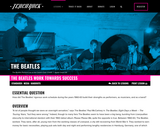
"A lot of people thought we were an overnight sensation," says The Beatles' Paul McCartney in The Beatles: Eight Days a Week “The Touring Years," "but they were wrong." Indeed, though to many fans The Beatles seem to have been a big bang, bursting from Liverpudlian obscurity to international stardom with their 1963 debut album Please Please Me, quite the opposite is true. Between 1960-63, The Beatles worked. They were, after all, young men from the working classes of Liverpool, a city still recovering from World War II. They worked to earn money for basic necessities, playing pub sets both day and night and performing lengthy residencies in Hamburg, Germany, one of which included a stretch of 104 consecutive shows. They worked on repertoire, learning dozens of "cover" songs spanning several genres. They worked on their group sound, playing several sets a night and fine tuning the skills that helped them "hold" audiences at the dance floor, even those who may not have come specifically to see them.

In this lesson, students learn about the impact of The Beatles on their teenage audience, particularly in relation to the group's image as a "rock band."
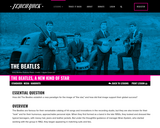
Essential Question: How did The Beatles establish a new paradigm for the image of "the star," and how did that image support their global success?
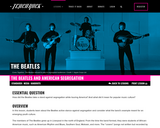
In this lesson, students learn about the Beatles active stance against segregation and consider what the band's example meant for an emerging youth culture.
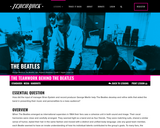
This lesson explores first the role Brian Epstein played in helping craft The Beatles' visual presence, group identity and team unity, the way he helped the group transition from successful nightclub act to international sensation.
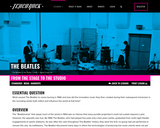
By the end of their 1966 summer tour, The Beatles had grown weary of the live concert setting. Concurrently, they had become increasingly comfortable within, and inspired by the possibilities of the recording studio. In the fall of 1966, in a culminating moment, The Beatles announced that they would no longer tour and would instead focus their creative energy on making records.
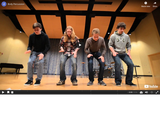
Video "Body Percussion"
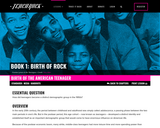
In this lesson, students will investigate how teenagers became a distinct demographic group with its own identity in the postwar years, and, in turn, how their influence helped push Rock and Roll into the mainstream. In so doing, they helped secure Rock and Roll's place as the most important popular music of the 20th century.

In this lesson, students will examine the emergence of the teen idols in the late 1950swith a particular focus on Dion and the Belmontsto understand how mainstream culture promoted the image of the "good citizen" teen during an era of increased anxiety surrounding youth culture. Students will listen to recordings of Dion and the Belmonts' "A Teenager in Love," as well as Dion's later recording "The Wanderer," in addition to viewing a 1958 instructional film outlining school dress codes, a 1953 trailer for The Wild One, a selection of teen magazines, and performances by Jerry Lee Lewis and Connie Francis.
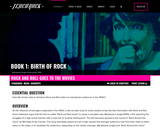
In this lesson, students assume the role of entertainment industry professionals responsible for marketing a selection of movies from the early Rock and Roll era. Following an examination of trailers, posters, newspaper articles, and the Motion Picture Production Code of 1930, students will present to the class on the various stakeholders that helped shape the way Rock and Roll culture was introduced to mainstream movie audiences in the 1950s.
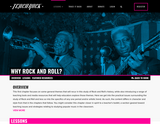
In this lesson we explore one song Chuck Berry's "Johnny B. Goode," released on Chess Records in 1958 and suggest several analytical frameworks in which one can deepen one's understanding of the song: using a listening template; using a timeline to understand a song's historical context; understanding Rock and Roll as a visual culture; understanding Rock and Roll as performance; understanding Rock and Roll as a literary form; and understanding the industry and technology of Rock and Roll. Of course, what we do with "Johnny B. Goode" can be done with any song. The objective is to understand a recording in the most complete way possible.
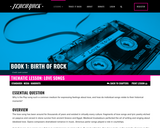
In this lesson, students will listen to examples of love songs from several musical styles and historical moments. The activities are designed to explore how music and lyrics work together to express different sentiments toward love and relationships.
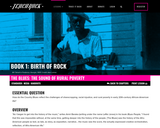
This lesson focuses on the music through which those hardships were expressed and on the daily lives of southern blacks in the sharecropping era. It is structured around an imagined road trip through Mississippi. Students will "stop" in two places: Yazoo City, where they will learn about the sorts of natural disasters that periodically devastated already-struggling poor southerners, and Hillhouse, where they will learn about the institution of sharecropping. They will study a particular Country Blues song at each "stop" and examine it as a window onto the socioeconomic conditions of the people who created it. Students will create a scrapbook of their journey, in which they will record and analyze what they have learned about the difficulty of eking out a living in the age of sharecropping.
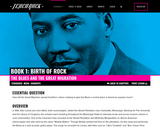
The repercussions of the Great Migration are far-reaching. Today, much of the restlessness and struggle that the Blues helped to articulate in the Migration era remains central in other forms of American music, including Hip Hop. In this lesson, students look to Muddy Waters and Howlin' Wolf as case studies that illustrate why African Americans left the South in record numbers and how communities came together in new urban environments, often around the sound of the Blues.

In this lesson, students will trace some of the technological developments that made the electric guitar possible. Using a variety of Internet sources, students will conduct research into some of the early models, including the hollow-bodied Gibson ES-150, introduced in 1936, and the Fender Telecaster, the first mass-marketed solid-body electric guitar, introduced in 1952, at the dawn of the Rock and Roll era. They will explore not only how these instruments transformed the Blues sound, but how they laid the groundwork for the development of the electric guitar as an essential Rock and Roll instrument.